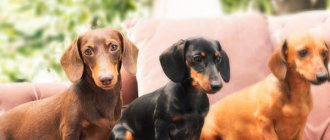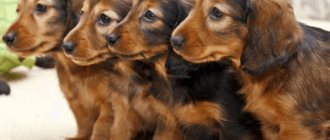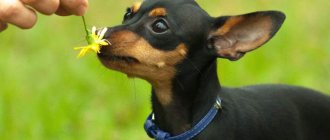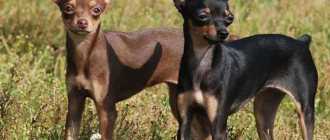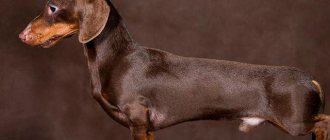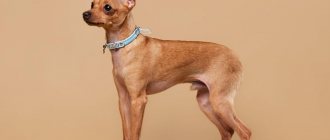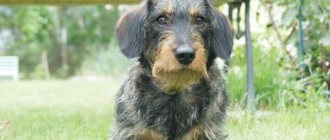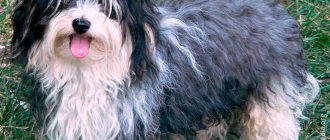In conditions of urbanization, city residents often give preference to small breeds that will feel more comfortable in an apartment. This includes the dwarf dachshund. Despite its small size, this dog has retained all the features of its hunter ancestors. After reading this article, you will learn how to properly raise a dog of this breed so that your pet becomes not only a faithful friend, but also an eternal joy in the home.
Breed characteristics
| Short description | |
| Origin: | Germany |
| Conditions of detention: | Apartment, house |
| Purpose: | Hunting dog, companion dog |
| Color: | Solid: brown, black, red, sand, bi-color: black and tan or brown and tan, merle: black, auburn or gray with spots, brindle |
| Wool length: | Short |
| Adult dog size: | Height 14-21 cm, weight – 4-5 kg |
| Average life expectancy: | 12-15 years |
| Walk: | Walking twice a day is required |
| Physical activity needs: | High physical activity needs (1.5-2 hours of active walking or training daily) |
| Fédération Cynologique Internationale (FIC) classification: | Group 4: Dachshunds, Section 1: Dachshunds |
| Puppy price: | From 10,000 to 12,000 rubles. Without pedigree - up to 10,000 rubles, pet class - 10,000 rubles, breed class - 11,000 rubles, show class - 12,000 rubles |
Price range
The price range for a dachshund is very wide, ranging from 2,000 rubles to 60,000 thousand rubles.
Price depends on:
- presence of pedigree;
- puppy age;
- availability of a veterinary passport;
- specialization of the dog (working or decorative);
- merits of parents (titles, awards, work diplomas).
History of the origin of the species
Dwarf Dachshunds, of course, descended from their older relatives, who were bred in Germany to hunt burrowing animals. Hunters needed a smaller version of the dog so that it could crawl into the smallest passages and quickly dodge wild animals.
In the 60s of the 19th century, under the leadership of dog handler Engelman, selection work began to develop a new breed line. The classic Dachshund was crossed with the Miniature Pinscher, but the result was not pleasing. The dogs had the right size, but lost their hunting abilities.
It was decided to find another way. The smallest puppies were selected from Dachshund litters and crossed with each other to arrive at a single miniature size. Despite the fact that smaller dogs produced fewer heads, enthusiasts were able to achieve the perfect appearance by the end of the 19th century. In 1880, the first breed standard was published, which included the Dwarf Dachshund.
Keeping and caring for dwarf dachshunds
Socialization of dwarf dachshunds takes place without problems, they quickly learn to be clean, and are friendly towards their roommates, including cats. Skin and coat care is no different; a long-haired dwarf dachshund will have to be combed periodically, and also taken to a “beauty salon” for grooming. Many experienced owners of long-haired dwarf dachshunds do an excellent job of grooming their coats on their own.
In conclusion, I would like to note that dwarf dachshunds are a special breed. If its representative gets it into his head that this is the right thing to do, then it will be difficult to convince the dog. To raise Dachshunds, you must have a special flair and great love for these unusually intelligent dogs.
Tags: animal care, comparison, hunting, choice of breed, breed, interesting fact, signs, dogs, dachshund
Distinctive features
There is no separate standard for the Miniature Dachshund. It is a subspecies of the standard breed and is considered its smaller copy: it reaches only 14-21 cm at the withers and weighs 4-5 kg. In addition to height variation, there are varieties based on coat length: smooth-haired, long-haired and wire-haired.
All Dachshunds are distinguished by a very elongated format, low stature and short legs. A similar physique can also be seen in the Basset Hound; in other breeds such parameters are considered defects. The proportions and shape of individual body parts are the same among the subspecies of the breed.
- The head is long, conical, tapering towards the nose. The stop is smooth, the brow ridges are pronounced.
- the muzzle is equal to the length of the skull. The jaw is strong with a full set of teeth and a scissor bite (the upper teeth closely overlap the lower teeth). Lips are thin.
- The nose is large. The color depends on the coat color.
- The eyes are small, almond shaped, set wide and slanting. Chocolate iris .
- The ears are set high, drooping, rather long and thin, rounded at the ends.
- The body is muscular, strong, elongated. The topline is straight and long, the withers are pronounced. The chest is well dropped . The neck is long, carried proudly and without dewlap.
- The tail is short, does not touch the ground, and is set below the back.
- The limbs are short, set wide and straight. The paws are large, powerful, oval with pointed toes. Movements are smooth, hobbling, jerking.
- The smooth-haired coat is: close-lying, straight, fine, smooth; Wire -haired : thick, wiry with dense undercoat; Long -haired : shiny, medium-length, wavy, soft, with a fluffy undercoat.
- Colors. Solid: brown, black, red, sand, bi-color: black and tan or brown and tan, merle: black, auburn or gray with spots, brindle
Photo of an adult dog
Photos of puppies
Features of character and behavior
Dachshunds are controversial dogs. On the one hand, these are small, cute, good-natured dogs with eternal optimism in their eyes and joy at the sight of a new person. On the other hand, these are brave hunters with a strong capricious character, primitive habits and open aggression towards those they do not like.
One way or another, puppies are very smart, quickly and easily trained, and adapt to different conditions. With proper upbringing, you can raise a good, faithful companion and assistant on the hunt.
Advantages
The clear advantages of the breed include:
- Sharp hunting instinct, good data: scent, hearing, speed;
- Security abilities are not inferior to large dogs;
- Friendliness, affection, devotion to family;
- Good relationships with children and pets (provided the animals grew up together);
- Activity, positivity, “ageless” soul;
- High intelligence.
Flaws
This is not the first year that this breed has graced the tops of the most aggressive dogs. There is some truth in this. Dachshunds are not very fond of strangers, members of the same sex, or annoying objects. Their nervous system is shaken, so cases of sudden aggressiveness cannot be ruled out. With proper parenting and proper upbringing, the chance of getting an uncontrollable, angry dog is minimal.
Common breed disadvantages include:
- Stubbornness, willfulness;
- Cunning, characterized by evasion of training and education;
- Tendency to escape;
- Destructiveness (like to gnaw, dig, drag, tear);
- Selfishness, jealousy of owners and personal items.
Video about the breed
Care and maintenance
These dogs are not suitable for outdoor living, but they get along well in small apartments and houses. Their size allows them to sleep anywhere without taking up much space. In addition, smooth-haired Dachshunds require virtually no grooming, which cannot be said about long-haired ones. The future owner always has a choice of which subspecies of Dachshund he wants to keep.
Before buying a puppy, they will arrange a place in the house. It should not be exposed to drafts or exposed to direct sunlight. It is also worth purchasing a soft lounger, bowls on stands, toys, and hygiene products.
The dog needs frequent and active walks, and best of all, hunting. Therefore, you should not have her as a sofa pet.
Nutrition
Dachshunds can be real nasty eaters. Some of them not only reject dry food, but also do not recognize thermally processed foods. One way or another, the choice between ready-made food and natural food is not obvious. Dog owners often stick to the first option because it is convenient, fast and comprehensive. The pet does not need to be fed additional vitamins.
When choosing dry food, special attention should be paid to the composition. It is also worth reading reviews and opinions, and consulting with the breeder. Dachshunds will benefit from super-premium food for small active breeds. The best option would be holistic – grain-free products.
Natural nutrition must include proteins and carbohydrates. About 50% of the daily menu should be given to lean meat, sea fish, cottage cheese, kefir, and eggs. Another 40% are cereals - cereals cooked in water or broth. A puppy should be taught vegetables from an early age. Dachshunds love fresh carrots, apples and pears.
The diet should not contain butter, pork, bones, flour and confectionery products, smoked, fried and fatty foods. You cannot feed your dog from the table or mix natural and dry feeding. When changing power supply, the transition should be smooth.
Dwarf dachshunds need about 200-400 grams of dry food per day. The serving size varies depending on the activity and weight of the animal, and the time of year. Dogs need less food in summer than in winter. Puppies up to 3 months are fed 5-6 times a day, up to six months - 4 times , and by one year they switch to two full meals a day.
In addition, it is important to maintain a drinking regime. If the puppy does not drink, he is given water from a spoon, syringe or pipette. The water bowl should always be full, and drink bottles should be taken on walks.
We recommend that you read a detailed article on the topic: “How and what to feed a dog: types and characteristics of nutrition.”
Health
This breed is considered quite healthy. T axes can live up to 15-17 years with proper care. There are several congenital pathologies, so before purchasing a puppy you need to have it examined by a doctor. It will be useful to find out about your parents' health problems.
Vaccinations
Vaccination never fully guarantees that a pet will not become infected with an infectious disease. Although the immune system of a vaccinated animal is strong enough to ignore the virus and quickly return to normal after encountering it.
Unvaccinated pets are unable to survive the disease. Puppies under one year of age and pregnant bitches are especially at risk.
Two weeks before vaccination, a deworming procedure (cleansing of worms) is carried out. On the day of admission, the animal’s temperature is measured (the normal value is 37-39°C). The pet must be absolutely healthy.
It is not allowed to vaccinate weakened dogs, pregnant and lactating females, or males after mating.
There are two vaccinations that a dog needs:
- Comprehensive (carried out at 2, 2.5, 6 and 12 months, annual repetition is required);
- For rabies (carried out at 7 months, annual repetition is required).
According to the laws of the Russian Federation and other countries, the import of unvaccinated animals into the territory of the state is prohibited. Condition: vaccination must be done in the last 12 months, but no later than 20 days before travel. In addition, the pet must be examined at a veterinary clinic and receive a health certificate.
Usually the first vaccinations are carried out by the nursery. The breeder issues a veterinary passport and sells the puppy with documents. The owner needs to know the vaccination schedule and medications. Medicine labels are pasted into the passport.
All procedures are carried out by a veterinarian in specially equipped points in order to provide first aid to the dog in case of an allergic reaction. If you experience prolonged side symptoms after vaccination, you should immediately consult a doctor.
Important article on the topic: “Everything you need to know about dog vaccinations.”
Diseases
Diseases characteristic of the breed:
- Diabetes;
- Food allergies;
- Obesity;
- Intervertebral disc diseases and paralysis;
- Heart problems;
- Genitourinary diseases;
- Cataract.
Walk
This breed is hunting and working. She needs to be given so much physical activity that all the activity is exhausting. Despite its small size, the standard practice is to walk the dog twice a day for 50-70 minutes. Active games, completing an agility course for short pets, and communicating with fellow pets are encouraged. In the summer, Dachshunds will not mind swimming in a camp or lake.
Puppies begin to be walked at 2-3 months, after the second vaccination. In the first 5 days they are simply carried out in their arms, sometimes lowered to the ground.
Later, you can teach him to use a leash, walk him 3-4 times a day for 15-20 minutes . Excessive exercise at this age will negatively affect your pet's health.
As socialization progresses, the puppy is first walked in quiet parks, later introduced to similar dogs, and the final phase will be a walk in a noisy crowded place or training in a group of animals.
Grooming
Caring for your Dachshund's coat depends on its length. If the dog is smooth-haired, then it needs to be wiped with a suede cloth a couple of times a week, removing dead hairs.
Wirehaired animals are trimmed every 3-4 months using special pliers (you can do the procedure yourself, or contact a groomer). Long-haired dogs are brushed every day with a brush with long metal teeth.
Pets are bathed no more often than once every 3-4 months . After walks, you need to wash your paws and dry your fur with a towel. Brush your teeth 3-4 times a week with chewing cords or paste. The eyes and ears are inspected daily for inflammation or discharge and wiped as they become dirty.
During the summer, dogs must be treated for ticks and fleas. The pet is cleaned of helminths (worms) once every 2 months. During the cold season, animals are dressed in protective overalls.
What to do if your weight is below normal
- First of all, you need to worry about the health of the puppy. Perhaps weight loss is associated with a disease. After consulting with your veterinarian, you should review your puppy's diet. If the dog is fed natural food, it may be necessary to increase the proportion of protein products, not meat, but fermented milk, for example, cottage cheese, a source of calcium necessary for the proper development of the puppy. The veterinarian can also prescribe useful vitamin and mineral supplements. If you use ready-made food, you need to think about changing it to another, higher quality one.
- One of the reasons for weight loss may be insufficient walking time for the puppy.
- The presence of worms also affects the weight and height of the puppy. Usually the first anthelmintic is given two months before the first vaccination, but if there is a suspicion of the presence of worms, then the necessary measures can be taken earlier.
The dachshund, although it became a house dog, retained its lively and cheerful character . She will do well with an active, energetic and intelligent owner.
Mating
Mating begins with the owner of the breeding female filling out a special form at the nursery and receiving a referral. A typical male is selected in advance. The owners agree on a date so that the boy does not get involved with anyone during this period. The price is also determined.
To know approximately the date, you need to understand the girl’s cycles. The first heat begins at 8-10 months, but at this time the female is too weak to bear puppies.
The best favorable period is considered to be the 13-15th day of the third estrus (approximately 20-25 months of life). The swollen loop should soften and loosen, and the discharge should lighten.
Animals are introduced. To do this, they are either walked or left alone in the apartment. The act should take place on the dog’s territory so that he feels relaxed. You can invite a specialist to solve the problem. When the male lands, you need to hold the female under her belly and not let her sit. After several active pushes, the boy will find the loop and become locked.
The entire act will last 15-20 minutes. If animals fall or cannot find their balance, they can be covered with pillows or held. Repeated mating is prescribed after 48 hours.
Read a detailed article on the topic: “Everything you need to know about breeding dogs: appropriate age, what to do if it doesn’t work out, rules and tips.”
Key points in training
Dachshunds need to be trained, even such small ones. This is a hunting breed, it has all the necessary instincts and an independent temperament. Despite this, puppies quickly understand commands and are easy to train.
It is worth teaching them a few rules:
- Food is given after the whole family has left the table;
- You can only enter the house after the owner;
- Taking food from the hands of strangers is prohibited;
- Jumping and sleeping on the master's bed is unacceptable.
Thanks to these habits, the dog will understand the hierarchy of the “pack” and accept the person as the leader.
By 3-4 months, the puppy will remember its name and daily routine. At this time, you can start learning basic commands. If the owner thinks that he cannot cope, then the right thing to do is to contact the kennel club.
The animal must know and clearly follow the commands: “No”, “Nearby”, “Place”, “Voice”, “Quiet”.
A separate role in raising a puppy is its socialization. A properly socialized dog will not be aggressive or timid. From childhood, the dog is introduced to people and pets so that it accepts the safety of the world around it.
You cannot use rough methods, especially assault. Dachshunds will be offended, become embittered and stop trusting the person.
The engine of progress is motivation. The puppy should be encouraged with a treat and a kind word. For punishment, a stern look or ignoring is enough.
Read about how to properly train a dog in the article: “Training a puppy: effective methods from dog handlers, learning commands at home.”
Learning ability
The dachshund is easy to train - it is smart. Requires a consistent approach to training and thoughtful commands. First of all, train your dachshund puppy to:
- to the nickname;
- to the leash;
- to the collar;
- to the muzzle.
Next, teach the commands “Come to me”, “Sit”, “Lie down”, “Near”, “”. Require your dog to maintain discipline in the house. Once you have prohibited climbing on the bed, stop the dog every time it tries to lie on the pillows. Be consistent in your requirements.
If your dachshund is stubborn, enforce the command and take a break. But don’t fall for the dog’s tricks - distinguish between real fatigue and pretend fatigue.
After completing a general training course, you can train the dog to hunt game if you plan to use it for hunting.
How to choose a puppy
When choosing a puppy, you need to start from the desired future functions of the dog.
- If she is purchased as a pet, then the pet class is suitable.
- If for breeding, then a breeding class.
- And if for a stellar exhibition career, then show class.
Dogs may differ in appearance and price.
You also need to decide on the gender and age of the dog. Girls are always more flexible, but boys are more temperamental. You can pick up a puppy from its mother at 2-3 months . This age is considered the most popular. Little dogs are cute and can be trained from scratch. But there are more problems with them than with an adult dog: frequent feeding and walking, a busy vaccination schedule. At 5-6 months, dogs become more independent, their appearance can already be assessed with confidence. But few people can re-educate a fully formed personality.
Buying a Dwarf Dachshund is not difficult. This breed is very common. Therefore, the choice between an official nursery and a private person depends only on the wishes and financial capabilities of the owner.
It is worth noting that a reputable breeder will take care of the dog’s documents. He will inform the future owner about the breed's diseases and deficiencies and show the parents. He will also help you make a choice and give advice on care and education.
Puppies should not have obvious defects or pathologies. They will be active, playful and curious. The average price for such an animal is 10-12 thousand rubles. It may vary depending on the class of the dog.
Dachshunds are cute and funny animals, but they are quite temperamental. These dogs are suitable for active people who are willing to spend time raising and training the animal.
Health
It is not particularly strong in a miniature dachshund. Above, we promised to tell you why representatives of the breed should not jump. This is fraught with spinal injuries. Up to displacement or damage to the spinal discs.
Cataracts are a common companion of dachshunds. They may even have problems with their eyes.
Representatives of the breed are also prone to enteritis. It occurs due to poor nutrition and frequent overeating.
